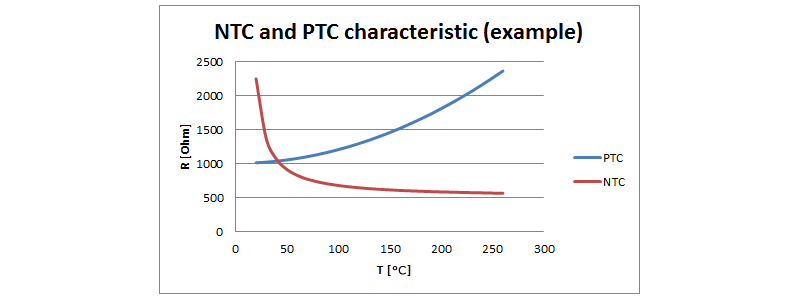Characteristic curve
The linear approximation is valid only for a small measuring range. In a larger measuring range (several 10 ... 100 kΩ are common), the characteristic curves for resistance calculation are defined with the help of exponential functions, since the change of the resistance value depending on the temperature is not linear and depends on the selected sensor. For the determination or exact conversion of the resistance value into a temperature value, these special characteristic equations are required.
The characteristic curves differ significantly, depending on the sensor selected, so there is no general PTC or NTC sensor, but many different resistance sensors with special characteristics that belong to the PTC or NTC family.
Typical characteristic equations are:
- For platinum/Pt sensors (PTC) according to e.g. IEC 60751 or ASTM-E1137 (so-called Callendar-VanDusen equation):
- Measuring range -200 °C … 0 °C:
R(T) = R0(1 + AT + BT2 + C(T – 100 °C)T3) - Measuring range 0 °C … 850 °C:
R(T) = R0(1 + AT + BT2) - For NTC (semiconductor thermistors)
- Steinhart-Hart:

- B-parameter equation:

- The 6th order equation for Ni sensors according to DIN 43760 (withdrawn), e.g. for 6180 ppm/K
The various factors A, B, C, R0 and T0 are to be specified by the sensor manufacturer or can be determined by measuring the resistance at known temperatures. The parameter R0 indicates the resistance in Ω of the platinum sensor at T = 0 °C. The sensor designations are based on these characteristics, e.g. for Pt100 R0 = 100 Ω at T = 0 °C.
The B-parameter equation is a simplified version of the Steinhart-Hart equation. The B parameter itself is only constant in a small range, e.g. between 25 °C … 50 °C or 25 °C … 85 °C. This is designated B25/50 or B25/85. The accuracy of the equation strongly depends on the B parameter. The larger the measuring range, the lower the accuracy. If a larger measuring range required, it is preferable to use the Steinhart-Hart equation.
For illustration purposes, typical characteristic curves for NTC and PTC sensors are shown in the following figure:
 Fig.9: Examples for temperature dependent resistance values
Fig.9: Examples for temperature dependent resistance valuesIn principle, a sensor manufacturer can of course also publish the characteristic curve of his sensor informally as a table of values, as is done, for example, with KT/KTY sensors.
So there is no general NTC or PTC sensor, but these are designations for sensor families with a specific behavior.